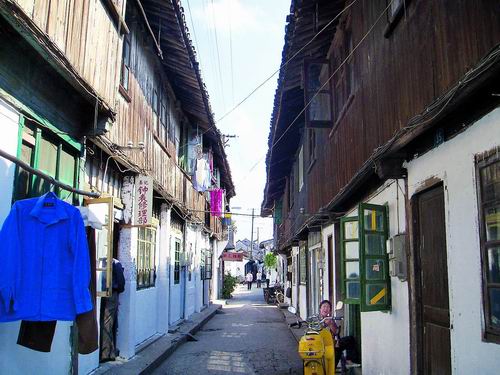
Shanghai Daily News
Shanghai boasts many typical water towns on the outskirts of the city,
however, Qingcun is somehow neglected. With a history of more than 1,000 years,
the newly discovered ancient town located in Fengxian District is only 40
kilometers from the city center, or 50 minutes by road.
Slab-stone houses, slate-paved roads and complete tranquility are all now
easily accessed.
Visitors roaming around the water towns, invariably retain in their memories
the evocative silhouette of rivers, lakes, stone bridges, real boats and houses
alongside the rivers and lakes.
Stone bridges epitomize the unique charm of water town. It can be said that
the beauty of the water town lies in its bridges and rivers.
Among them, the Nanhong bridge, a traditional arched bridge built during
Emperor Kangxi's reign (1662-1722 AD), is the most prestigious one of its kind
in Qingcun.
Standing on the bridge, visitors can have a bird's-eye view of the narrow
alleys and its reflection in the water. Vendors gather on the flat ground at
either end of the bridge for trade especially after dark. The time I lingered
around the bridge, a vendor was selling water chestnuts, a typical food of
Yangtze Delta area.
Like most traditional wood-frame architecture in the water towns, the houses
display wide eaves, giving considerable prominence to the tiled roof. Standing
row upon row alongside the bank, the wooden houses were mostly constructed
during Ming and Qing Dynasty (1368-1644, 1644-1912), featuring "Diaojiaolou"- an
architectural style that the front side of the house overhangs on the stone
stilts in the water while the backside is supported by a stone platform.
Households along rivers all have piers, where they take water, do washing, do
business with merchants on the boats and chat with neighbors.
The river piers are made in different shapes, some are small, some big, some
are vertical and some are parallel to the banks. Bigger piers can be used to
shelter boats from the rain while small ones can be used for doing washing.
Two-sided piers usually serve for public use.
Unlike other water towns which have become popular tourist resorts in
Shanghai, Qingcun is still a living town and retains its purity and honesty,
where daily life goes on with the same customs and conventions from hundreds of
years ago.
It has an obscure old village of white plaster row houses and narrow
slate-paved streets along the ancient canal, where the people seem to be still
living in "Red Mansion" times.
One can find a wood carver working at his age-old craft and ladies dressed in
unique local cloths sitting in their doorways all day long.
Teahouses are the most popular places in town and where local people
communicate with each other over a cup of green tea.
Early in the mornings, the local residents come from all directions with a
copper teapot in one hand and a cigarette in the other. It is also a great place
to play mahjong with a couple of friends on the Baxianzhuo, or Eight Immortals
table, an old-fashioned square table for eight people.
The old wooden houses of Qingcun look ageless and immovable, as though their
timbers have totally defied the ravages of time. Far and near, there are still
traces of Qingcun's historic past like a destroyed memorial archway.
The story goes that during the Ming Dynasty, there lived a famous
calligrapher named Zhangbi. For three generations his family worked in the
ministry department and the local people took great pride in it. Hence, the
creation of the memorial archway - memorial building erected in honor of
society's role models, was inspired.
There also lies a Catholic church in the west of Qingcun which was
established in the Qing Dynasty where an estimated 430 local Christians gather
together to attend the Mass.
Qingcun was once a prosperous commercial and transportation hub due to its
coastal location.
In Song Dynasty (960-1279 AD), the area was a salt field, a place where
salters settled down and exchanged goods. A former salt field once stretched
many kilometers from east to west.
Li Bai, a prominent Chinese poet in the Tang Dynasty (618-907 AD) praised the
area's high quality salt. In one poem he said it was as pretty as flowers and as
bright as snow.
During the most prosperous period, Qingcun's economy boomed with salt fields,
salt warehouses, handicraft factories, trick shops and copper shops everywhere.
While the salt is long gone, the area remains important as many relics have
been found buried in the ancient town. To this end, Qingcun water town in
Fengxian District, was recently added to government's "city heritage" list of
cultural assets, showing the importance the Fengxian District Government place
on the preservation of the ancient town.



